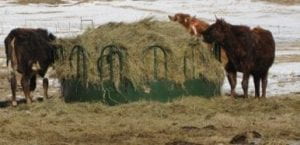
Hay Waste – It’s Expensive and Let’s Reduce the Waste
By Rich Toebe, CCE Livestock Educator
Feeding hay is part of every beef, sheep, or goat operation. On most farms, it is often the largest expense. Whether we buy our hay or make it ourselves, it is expensive and time consuming to obtain and store. And then there is more time and expense when we feed it out.
Although there are opportunities all along the way from making the hay to storing hay to feeding hay to reduce loss, we will limit this short conversation to reducing hay waste during the feeding stage. There are two principle ways to reduce hay waste: 1) feeder design and 2) managing frequency of feeding.
Feeder Design: All feeding systems have some waste. Just placing round bales on the ground unconfined can result in up to 50% of the bale not being eaten. Feeders that have solid lower sides are better than open bale feeders. Feeders with bottom sheets or trays with or without a basket or cone are even better- and can reduce waste to as low as 5% or 10%.
Managing Frequency of Feeding: Livestock will more completely utilize (and waste less hay) when fed a quantity that matches their need on a daily basis. The longer the hay is available (such as putting out a week’s supply at once), the more opportunity there is for the livestock to be messy with their feed and to trample it. This is particularly important when not using a feeder, rolling round bales out, or using a feeder without solid panels on the lower part of the ring.
Here’s one final thought: When hay was made and fed primarily as small squares, farmers were more closely aware of the waste associated when feeding it out. Round bales were a great labor-saving technology in putting up hay, but had an unintended consequence of putting the farmer in a tractor seat when feeding it out.

